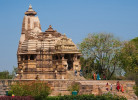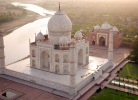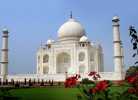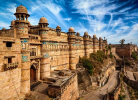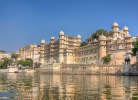Taj Mahal- Seven Wonders of the World
Standing on the bank of Yamuna River in Agra, Taj Mahal is one of the ‘Seven Wonders’ on the world. It is a marble mausoleum, built by Mughal King Shah Jahan for his beloved wife Mumtaz. Taj Mahal houses the tomb of Shah Jahan and his wife. It sprawls across an area of forty-two acres and features a manicured garden, a mosque and a guest house. The construction of this timeless monument started in the year 1632 and the entire complex was completed around 1653. The monument houses twenty-two white domes that symbolize the fact that it took twenty-two years to complete the Taj Mahal.
Ustad Ahmad Lahauri was the main architect for the project. He was led by several other architects and twenty thousand artisans including carvers, dome builders, masons, calligraphers and more. Today, the Taj Mahal is a masterpiece depicting extravagant Indo-Islamic architecture. The ivory white marbles adorned with intricate carvings and precious stones make it one of the most iconic heritage sites across the globe. It symbolises the rich history of our country and attracts millions of visitors every year. In 1983, the Taj Mahal has been announced as a UNESCO World Heritage Site.
It is said that Shah Jahan has spent thirty-two million rupees in the construction of this sparkling white mausoleum. The components used in its construction were brought from different parts of the globe and thousands of elephants were used in the transportation purpose. Taj Mahal is a slice of paradise for heritage buffs where they can marvel at the exemplary architecture and admire its irresistible charm. Apart from tourists, international celebrities have also visited the Taj Mahal including Tom Cruise, Leonardo Di Caprio, Princess Diana, Hillary Clinton, Oprah Winfrey and many more.
Brief About Taj Mahal
Taj Mahal was constructed by Shah Jahan in the 17th century in the fond memory of his wife Mumtaz. The land where the Taj Mahal stands today originally belonged to King Jai Singh. As mausoleums cannot be built on gifted plots, Shah Jahan bought the piece of land after exchanging five of his Havelis. Today, the Taj Mahal is a national heritage site and the entry is strictly based on tickets.
History of Taj Mahal
The history of Taj Mahal goes back to the Mughal era during the reign of the great King Shah Jahan. His wife Mumtaz was his inseparable companion and he loved her dearly. In 1631 Mumtaz died due to excessive blood loss while giving birth to their fourteenth child. Her death came as a shock for Shah Jahan and he started the construction of a mausoleum for his beloved wife in 1632. It took twenty-two years to complete the entire complex. Today, Taj Mahal is regarded as the symbol of love and the tombs of Shah Jahan and Mumtaz rests in this ethereal monument.
Story of Taj Mahal
The heartwarming story of Taj Mahal adds soul to its beauty. It is a story of love and loss. Shah Jahan was head over heels for his wife Mumtaz Mahal. He got engaged to her at a tender age of fifteen years and married five years later. Mumtaz died in the year 1631 while giving childbirth and her body was temporarily buried at Zainabad in Burhanpur. Later in 1632, Shah Jahan commissioned around twenty thousand labourers and several architects who worked on the construction of this eternal monument. Taj Mahal has been renovated several times but even today it is regarded as the true embodiment of love and romance.
Inside the Taj Mahal
The interior of the Taj Mahal never fails to enthral visitors. The carved interiors decorated with unique mosaic designs are a feast to the sore eyes. The main mausoleum backed by four minarets forms the heart of the monument. In the central chamber lie the cenotaphs of Shah Jahan and Mumtaz Mahal. The cenotaphs are engraved with verses from the Quran, the holy book of the Muslims. Apart from the cenotaphs, the mosque and the guest house at both the sides of the monument look equally fascinating.
Taj Mahal Myths
There are several myths attached to the iconic Taj Mahal but none of these is proven to be true. Some of the most popular myths are
- The construction of the Taj Mahal has been led by an Italian architect
- Shah Jahan wanted to build the Taj Mahal for himself and not for his wife Mumtaz Mahal
- Taj Mahal faced demolition in the year 1830 under Governor Lord William Bentinck
- The monument faced the threat of air attack in 1942
- The shape of the Taj Mahal is often regarded asymmetrical
- Shah Jahan wanted to build a mirror image of Taj Mahal in black marble
- Shah Jahan chopped off the fingers of the labourers involved in the construction of the monument
Taj Mahal Garden
Taj Mahal boasts of a lush manicured garden that looks straight out of a postcard. It is a Timurid style garden filled with several trees and plants. According to Islamic texts, water plays an important role in the creation of a paradise on land. Hence, the garden is known as Charbagh where the water channels divide the lush garden into four equal parts. A pond rests at the centre of the sprawling garden and its water is considered holy.
Reasons to Visit the Taj Mahal
Taj Mahal is the symbol of eternal love between Shah Jahan and his beloved wife. Hence, it has a romance factor attached to it. The beauty of Taj Mahal can be best relished on a lunar night. There are several reasons why millions of tourists from every part of the world visit the Taj Mahal. A few of the reasons are as follows.
- Taj Mahal is an architectural masterpiece and its beauty cannot be expressed in words
- Makrana Marbles were used in the construction that was brought to Agra from Rajasthan
- The estimated cost for building the Taj Mahal was around thirty to million rupees
- Taj Mahal is one of the great places where you can use your photography skills
- International celebrities visited the Taj Mahal including Leonardo Di Caprio, Hillary Clinton, Mark Zuckerberg and the list continues
The architecture of the Taj Mahal
Taj Mahal is one of the finest examples of Muslim architecture. It sprawls across an area of forty-two acres and features the Indo-Islamic architectural style. The Taj Mahal is surrounded by lush gardens, water bodies and fountains that add to the beauty of the complex. The complex comprises of five structures – main mausoleum, garden, mosque, guest house and the main gateway. The mausoleum is the main highlight and it stands on a raised platform on the bank of River Yamuna. The four minarets standing on each side enhance the aesthetic appeal of the monument. They are slightly tilted to protect the tomb from any damage caused due to natural calamity.
Tips for Visiting the Taj Mahal
- Try visiting Taj Mahal during sunrise and relish the majestic sight of the monument dazzling in the first ray of the sun
- Watch the monument on a cool, moonlit night and you will be awestruck by its charm
- Photography is prohibited in the main mausoleum
- Ticket price includes a 500-millilitre free water bottle and a shoe cover
- Free Wi-Fi services are available for thirty minutes and after that, it is charged at INR 30 per hour
- The audio guide is available at the ticket counter at INR 118
Best Time to Visit the Taj Mahal
The Taj Mahal is open to visitors throughout the year. However, winter is considered the best time to experience the monument at its glorious best. October to February constitutes the winter months when the temperature is cool and soothing. It is also the time of the Taj Mahotsav, a ten-day carnival that takes place in February.
Summer months in Agra are harsh and humid. Hence, it is not a good time for sightseeing. However, if you want to explore the Taj Mahal without the crowd, May to June is a perfect time. Monsoon starts in July and continues until September. Sudden outburst and frequent showers are common during that time. However, it is often difficult to explore the Taj Mahal during the rainy months.
How to Reach the Taj Mahal
By Air: Agra has its airport at a distance of 7 kilometres from the main city. The nearest international airport is in Delhi. There are daily flights that operate between Delhi and Agra. Other options include private cab, bus and train.
By Train: Agra is well connected with several popular destinations in India. There are three railway stations namely Agra Fort, Raja-ki-Mandi and Agra Cantonment. Apart from express and local trains, a couple of luxury trains also stops at Agra.
By Road: Several buses run between Agra and other prominent destinations in India. Daily bus services are available from Mathura, Delhi, Fatehpur Sikri and Jaipur.












